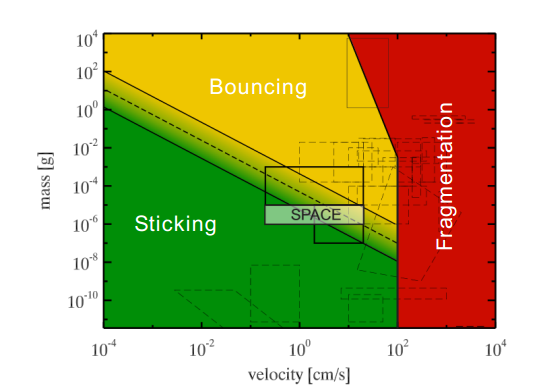A Student Space Mission To Study Planet Formation
The Esrange Space Centre is located in the Arctic Circle in northern Sweden close to the mining town of Kiruna. On 19 March last year, it hosted the launch of an unusual space mission to study the way planets form.

Astrophysicists believe that planet formation begins when micrometre-sized dust particles, the left-overs from star formation, become bound to each other to form millimetre or centimetre sized pebbles. These then aggregate into bigger rocks and so on. But exactly how this first stage happens isn’t well understood.
That’s partly because experiments to study this phenomenon are difficult to do on Earth. In this early stage of planet formation, the dust particles probably collide at velocities of less than 1 centimetre per second and this can only be reproduced and studied in microgravity conditions.
So the mission, called REXUS 12, was a suborbital hop that generated up to 3 minutes of microgravity in which to study how dust particles stick together. “The experiment was designed, built and carried out to increase our knowledge about the processes dominating the first phase of planet formation,” say Julie Brisset and pals at the Technical University of Braunschweig in Germany.
The space mission was unusual because Brisset and several of her colleagues are students working towards their PhDs. REXUS stands for Rocket Experiments University Students, a project that is funded in large part by the German Aerospace Centre DLR.
The experiment is reltively simple. It consisted of a machine that shakes glass containers of dust to produce particle collisions of the required velocity. The dust was made up of sub-millimetre grains of spherical and irregular silicon dioxide. Brisset and co videoed the entire experiment at a rate of 170 frames per second to see exactly how the dust particles behaved in microgravity conditions.
They say they learned some valuable lessons about the practicalities of this kind of work. For example, their glass containers were specially coated with an anti-adhesive layer designed to prevent the dust sticking to the walls of the container.
But this was not as efficient as they had hoped. “The dust aggregates … possess a very high sticking efficiency with the glass walls of the particle containers, even though these were actually coated with a nano-particle anti-adhesive layer,” say Brisset and co. So finding better ways to prevent this kind of sticking will be important in future.
They also noticed that the microgravity conditions during the experiment were far from perfect and that this caused some of the dust to accumulate in one corner of the containers. Brisset and co say this was the result of accelerations caused by residual atmospheric drag and the spin of the rocket.
The team also say that if they had the chance to run the experiment again, they would use a camera with more internal memory so that they could use a higher frame rate for recording the data.
Brisset and co have yet to publish a detailed analysis of their data. But when particles collide there are essentially three possible outcomes: they can bounce, stick together to form larger particles or fragment into smaller particles. Theorists believe that the outcome depends only on the mass of the particles and their velocity and have created a kind of phase diagram showing what ought to happen for different values of these variables (see diagram above).
The images in this paper do indeed show how dust aggregates combine to form larger particles. It’ll be interesting to see whether the data provides any more detailed insights into this process and whether the theoretical predictions of the way dust aggregates actually match their experimental observations.
Ref: arxiv.org/abs/1308.3645 : The Suborbital Particle Aggregation And Collision Experiment (SPACE): Studying The Collision Behavior Of Submillimeter-Sized Dust Aggregates On The Suborbital Rocket Flight REXUS 12
Keep Reading
Most Popular
Large language models can do jaw-dropping things. But nobody knows exactly why.
And that's a problem. Figuring it out is one of the biggest scientific puzzles of our time and a crucial step towards controlling more powerful future models.
The problem with plug-in hybrids? Their drivers.
Plug-in hybrids are often sold as a transition to EVs, but new data from Europe shows we’re still underestimating the emissions they produce.
Google DeepMind’s new generative model makes Super Mario–like games from scratch
Genie learns how to control games by watching hours and hours of video. It could help train next-gen robots too.
How scientists traced a mysterious covid case back to six toilets
When wastewater surveillance turns into a hunt for a single infected individual, the ethics get tricky.
Stay connected
Get the latest updates from
MIT Technology Review
Discover special offers, top stories, upcoming events, and more.